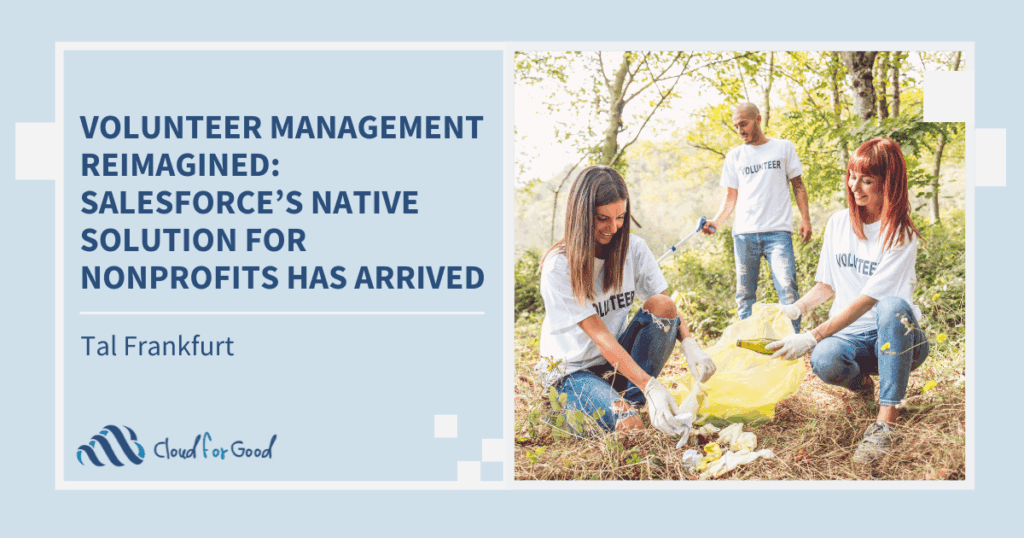Fundraising is hard work. It requires excellent relationship-building skills, a strong understanding of the funding landscape in your community, and strategic decision-making. Juggling the various tasks of a development officer can be overwhelming to say the least, but every day development teams keep as many balls in the air as possible to ensure their nonprofits are able to continue working toward their mission and vision.
Given the many moving pieces, implementing Salesforce at your organization can be game-changing for your development team’s operations. Not only is Salesforce an incredibly robust constiutent relationship management (CRM) platform designed to manage and track relationships (which is crucial for development work), but with the Nonprofit Success Pack (NPSP) it becomes a formidable fundraising tool that can streamline operations that may feel disparate at best and non-existent at worst.
At the end of the day, maximizing your team’s use of Salesforce can free up your development officers to do what they do best: connect with donors in your community to involve them in the work your organization does.
While there are many processes that keep a strong development team operating on a day-to-day basis, here are five basic fundraising processes your development team and you can (and should) track entirely in Salesforce:
- Gift processing – Salesforce’s open API and flexible format allow integrations with many peer to peer and crowdfunding platforms (think Classy, Rallybound, and Donor Drive, to name a few) and makes it possible to reflect your nonprofit’s gift processing requirements within your Salesforce org. The NPSP makes it even easier to process gifts by keeping track of general accounting units (especially helpful with restricted grant funding), recurring donations, and payment information. Pro tip: talk to your finance and/or accounting team to see what portions of their side of the gift processing work they could accomplish in Salesforce alongside yours. It will make reconciling your numbers at the end of the fiscal year faster and more accurate.
- Moves management – Strategic, nimble decision-making enables strong moves management. Salesforce allows development teams to reference up-to-the-minute information on the gifts in their pipeline, giving development officers the data they need to hit their goals and engage with their donors more effectively. Flexibility within the system allows you to look at your donors in buckets (for example, all donors in a “negotiation” stage), or at a more granular, individual level. For example, let’s say that, when analyzing your data, you notice your team has a lot of gifts sitting at the “negotiation” stage. With that knowledge fresh in your mind, you can brainstorm some great ways to secure pledges and gift payments as soon as possible to keep your funding pipeline moving. Keeping your moves management process and information up to date in Salesforce may help inform more strategic campaigns, appeals, and stewardship touchpoints in the future.
- Grant process and deadlines – Juggling tons of grant-related dates and deadlines? You’re in good company – most nonprofits are. Fortunately, the NPSP includes fields you can use to record those deadlines, and Salesforce’s reporting capabilities allow you to track those dates in a way that works for you and your team. Not only that, you can attach files directly to the relevant grant’s record, or link to relevant files, and make sure all information related to your grants lives in one easy-to-find place.
- Donor stewardship and touchpoints – The root of all great fundraising work lives in the relationships you build between your organization and your donors. Reflecting the work done to build those relationships – the events, meetings, phone calls, and emails – can seem overwhelming and often doesn’t make it out of a development officer’s head and into a system the rest of your team can reference. Fortunately, all the stewardship and touchpoints your team engages in with donors can be represented in Salesforce. The Campaigns object can be a great way to represent interconnected appeals, events, or initiatives, and the Activities object can provide more context into individual one-on-one interactions. Not only that, custom objects and fields can be used to provide more nuance into the work your team is doing to build and maintain strong relationships with your donors.
- Donor networks and connections – Every fundraiser knows the best way to source new donor prospects is through their existing donors’ networks and connections. Salesforce and the NPSP gives fundraisers the ability to track these crucial relationships in a variety of objects designed to reflect the interconnectedness of your donors’ real lives. On each donor’s record, you could see who else they serve on boards with, who their family members are, and even which of your program participants they may have a relationship with! Imagine how powerful your development team could be, armed with a sophisticated understanding of how your donors are interrelated throughout your community.
While it may take take time to implement or customize your Salesforce org to include these five development processes, at the end of the project you will have robust systems that are supported by the incredible power of Salesforce. Now that’s what we call working smarter, not harder!
Related Posts





